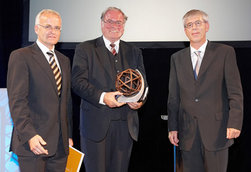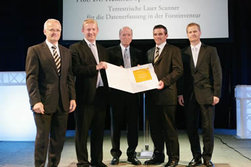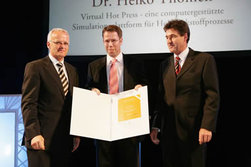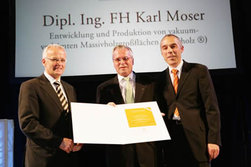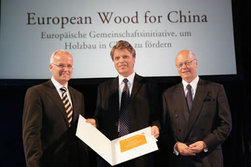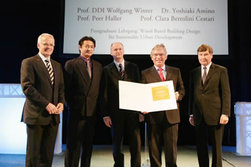Winners 2005
Main Prize
Prof. Julius K. Natterer
Prof. Natterer describes himself as „civil engineer, design engineer, professor, researcher and developer”. His civil engineering bureaus in Germany and Switzerland as well as the professorship for wood design engineering (the only one in Europe) in Lausanne represent International Centers of Excellence. Generations of outstanding civil or design engineers and architects have been trained by Prof. Natterer. As head of the Institute for timber constructions at the ETH Lausanne (IBOIS) he implemented innovative ideas and methods within traditional materials research, and in the development of structural connections and the conception of wooden structures. Revolutionary wooden constructions are the main challenge of Prof. Natterer. The implementation of completely new solutions always served as a proof for the practicability and reliability of the newly developed techniques. The new findings have always been offered for public use.
CATEGORY FORESTRY INNOVATION PRIZE
Terrestrial Laser Scanners for Forest Measurement Applications
Prof. Dr. Heinrich Spiecker:
Prof. Spiecker is head of the Institute for Forest Growth at the Albert-Ludwigs University in Freiburg, Germany, which is the first research institution worldwide that has used terrestrial laser scanning data to determine forest inventory parameters as well as quality assessments of single trees.
Enda Keane:
Enda Keane has worked in the forest industry for ten years as forest manager. In 2001 he formed a technology company. In 2004 he and his partner Garrett Mullooly concentrated in setting up Tree-Metrics Ltd which is also involved in the laser scanning sector.
The project:
Terrestrial laser scanners have the potential to provide timber growers and processors with signifi-cantly more information about the quality and value of individual tree stems in a forest than conventional inventory methods. One major advantage of scan data technology is that a significant amount of data are captured and stored for subsequent analysis. In essence, a 3D image of individual stems can be captured in the field and subsequently measured in a virtual office environment and, with the use of appropriate data processing and interpretation software, the compilation and analysis of large amounts of measurement data is possible. This will lead to many advantages for forest owners and buyers in the fields of supply chain analysis, forest valuation and optimisation and simulation of forest harvesting.
CATEGORY WOOD TECHNOLOGY INNOVATION PRIZE N°1
Wood Welding
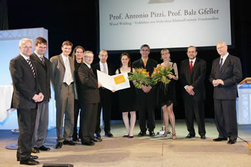
eft to right:
Gerald Schweighofer, Luc Delmotte, Frédéric Pichelin, Mario Lehmann, Antonio Pizzi, Haruhiko François Kanazawa, Stefanie Wieland, Jean-Michel Leban, Milena Properzi, Balz Gfeller, Bo Borgström
Prof. Pizzi is professor of industrial chemistry at the University of Nancy (France), and additionally deputy director of LERMAB (Laboratoire d’Etudes et Recherche sur le Materiau Bois), also at the university of Nancy.
Prof. Galz Gfeller is Professor of Materials and Processing at Berner Fachhochschule – Hochschule für Architektur, Bau und Holz in Biel (Switzerland).
Both are leaders of very successful teams of young scientists who were also awarded the prize:
Dr. Luc Delmotte
Dr. Haruhiko Francois Kanazawa
Dr. Jean-.Michel Leban
Mario Lehmann
Dr. Frederic Pichelin
Dr. Milena Properzi
Dr Stephanie Wienland
Dr. Michaela Zanetti
The work has been carried out at two different institutions: Berner Fachhochschule – Hochschule für Architektur, Bau und Holz in Biel (Switzerland) and at LERMAB at the University of Nancy in France.
Each institution is the originator of one of the two submitted welding processes. Two systems of welding wood without adhesives have been developed. (1) Vibration welding, used to weld two flat wood surfaces to each other. (2) High speed rotation welding of wood dowels into wood substrates, used to join several wood specimens with everyday, inexpensive equipment. Both systems of wood-to-wood welding are based on the melting and flowing of the amorphous cells interconnecting polymer material in the structure of wood—mainly lignin, but also hemicelluloses. The high temperature rapidly reached at the interface, and at the interface only (>180°C at the interface but still 20°C at less than 1 mm from it) for an extremely short period (1 to 3 seconds). This causes partial detachment, the "ungluing" of long wood cells, wood fibres, and the formation of a fibre entanglement network in the matrix of molten material which then solidifies. Thus, a wood cell/fibre entanglement network composite having a molten lignin polymer matrix is formed.
At the European level the use of this system, especially wood dowel welding, will spare considerable amounts of adhesive, in the thousands of tonnes, to the wood industry; it would render certain sectors of the wood industry more or even totally independent of the chemical industry, and would make joinery totally environmentally friendly as joinery elements would be composed exclusively of wood.
CATEGORY WOOD TECHNOLOGY INNOVATION PRIZE N°2
Virtual Hot Press
Dr. Heiko Thömen:
Dr. Thömen is a scientific member of the Department of Wood Technology at the University of Hamburg (Germany). He is leading a research team concerning wood panels.
The Project:
In close cooperation with the Department of Wood Science and Engineering at the Oregon State University, the Department for Wood Technology at the University of Hamburg developed a physical-mathematical model for the description of hot press processes within panels. The application-oriented software, called Virtual Hot Press (VHP), is available on the market since 2003. VHP is software for simulation and visualisation of the main parameters concerning the processing and products associated with the hot press process of Medium Density Fibreboard (MDF), particleboard and Oriented Strand Board (OSB). For instance, the following parameters for the optimisation of the processing speed can be predicted: temperature of the panel, density profile perpendicular to the panel surface (vital for mechanical properties) and the development of the tensile strength perpendicular to the grain.
The software provides an important instrument for the European panel industry in helping to reduce costs and time, by replacing trial-and-error methods. Also, the early detection of abortive developments will contribute to increasing the competitiveness of the European panel industry.
CATEGORY TIMBER PRODUCTS INNOVATION PRIZE
Development and Production of Vacuum Bonded Wood Structural Elements
Dipl. Ing. FH Karl Moser:
Karl Moser is CEO of the Merk-Project GmbH, a structural company owned by the Finnforest group in Germany. Additionally, Karl Moser is President of the German Society of Wood Research and board member of the Cooperation of industrial research units. Karl Moser was the first to develop multifunctional wood based structural members called “Dickholz”, today known as “Leno®”. The oversized elements (so far up to 0.40 x 4.80 x 25.00 m) are made of crosswise-laminated boards comparable to plywood. In special cases panels or other two-dimensional materials can also be used in combination with wooden boards. The gluing is made using an especially developed vacuum method. The product can easily be produced according to individual requirements such as direction of the boards, number of layers, strength properties and surface qualities. The specific production process is improving the dimensional stability of the used boards; therefore even low quality wood can be used. Thus Dickholz represents a real added-value product for the European market.
CATEGORY MARKETING AND TRAINING INNOVATION PRIZE N°1
European Wood
European Wood:
European Wood is a cooperation project, formed during 2004 by the national wood export promo-tion organizations FrenchTimber, German Timber Promotion Fund, Nordic Timber Council (representing Finland, Norway and Sweden) and ProHolz Austria. It is intended to continue for several years. The aim is to increase and stimulate wood consumption through generic wood promotion in China.
The Project:
European Wood in China has originated from the experiences of the successful work of the national export promotion organizations in Japan, and the prospects of relieving output pressure in Europe through export of large volumes from Europe. China is of great interest for export from Europe, since it is the biggest (1,3 billion inhabitants) and most rapidly developing construction market in the world. China today builds approximately 1.9 billion square metres of non-wood buildings per year, and is in principle the most under-exploited market for wood solutions. By introducing European wood construction methods, such as infill wall systems, interior wall systems and roof systems all in wood, shortcomings in the prevailing Chinese construction system can be solved without changing the traditional appearance of the building. This gives a more favourable outlook for acceptance.
CATEGORY MARKETING AND TRAINING INNOVATION PRIZE N°2
Interdisciplinary und Interuniversity Postgraduate Training and Research: “Wood Based Building Design for Sustainable Urban Development”
In order to realise high-level teaching with a cosmopolitan outlook, the course is organised by an alliance of three centres of excellence. They are the Institut für Architekturwissenschaften, Tragwerksplanung und Ingenieurholzbau in the Technical University of Vienna (TU Wien), represented by Prof. Wolfgang Winter and Dr. Yoshiaki Amino, the Lehrstuhl für Ingenieurholzbau und baukonstruktives Entwerfen in the Technical University of Dresden (TU Dresden) represented by Prof. Peer Haller, and the Dipartimento di Progettazione Architettonica e Disego Industriale of the Politecnico di Torino, represented by Prof. Clara Bertolini- Cestari.
The central subject of teaching focuses on the application of wood to the development of sustainable cities. The students will obtain the necessary skills for directing the design and construction of major timber buildings in an urban context and the development of timber building systems and wood-based materials on the basis of technical and economic mastery of wood. In their areas of competence the three Institutes cover different seminars: Wood based material design for future buildings at TU Dresden, restoration of historic timber buildings at Politecnico di Torino, and urban multi-storey buildings in natural materials at TU Wien. These seminars will be supported by many foreign universities. In particular, there is an intention to reinforce the relationship with the universities in Eastern Europe and Asia. Regarding the market potential of these zones, international talents will play the role of a bridge. The first course will start in October 2006 and close in June 2008. Thereafter the course will be organised every two years.


